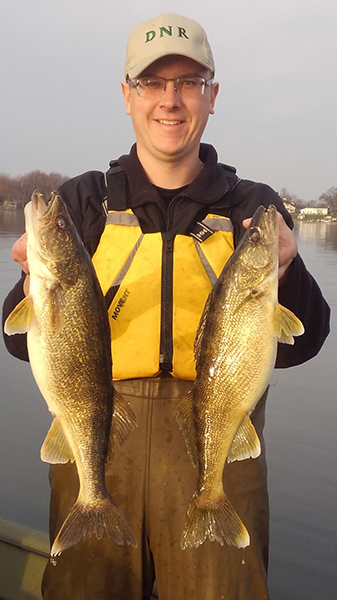By Louie Stout
 Indiana Biologist Tom Bacula
Indiana Biologist Tom Bacula
Indiana Biologist Tom Bacula shows off a pair of nice walleyes his crew collected during a survey on Lake Maxinkuckee. Bacula was impressed with the numbers and quality of walleyes his crew turned up. (Indiana DNR photo)
If you fish Lake Maxinkuckee in Culver, Ind., you probably know the lake has walleyes.
The 1,884-acre lake has been stocked with walleyes for several years. It has never been a great walleye fishery, but if you’re skilled at targeting the prized fish, you can catch a few legal-size fish.
Those odds are improving, however, as a recent DNR survey reveals the lake has more adult walleyes than ever and shows promise of getting even better.
Maxinkuckee is the second largest natural lake in Indiana. It has beautiful structure, habitat and good water quality that benefit a variety of gamefish.
Unfortunately, the public access leaves little to be desired. The DNR manages a boat launch but parking is limited to an area along the road.
It’s too bad, because the lake is a fabulous fishery for a variety of species.
Anyway, Indiana Division of Fish and Wildlife (DFW) District Biologist Tom Bacula was there last month conducting a survey of the adult walleye population.
He came away very impressed.
“The last time (2012) we did this kind of survey we caught 110 walleyes,” he said. “This year we caught 405.”
The DNR doesn’t capture every walleye in the lake but does get a sample size to compare to previous surveys.
Crews set trap nets during early April in shallow water where they believed the walleyes spawn. Fish sizes are documented before the walleyes are released back into the lake.
The majority of the fish that DNR staffers handled last month were 14- to 16-inch males, but they saw a lot of bigger ones, too.
“We had a lot of fish over 16 inches and they were all really nice looking fish,” Bacula said. “Around 46 percent of the fish we caught were legal length, something we didn’t see in 2012.”
The biggest male they handled was 20.7 inches and they saw females from 13.2 to 21.3 inches.
“We normally get a token mid-20s fish, but I would say the fishery is a lot more balanced in age and size structure now than it was when the same survey was done in 2012,” he explained.
Prior to that year, the DNR only stocked small fry into the lake. Since then, it has altered stocking by planting 5- to 7-inch walleyes at 10 per acre in the fall during even years and 1 to 2 inchers (100 per acre) early in the season of odd years.
Bacula believes the change in stocking methods with bigger, yet fewer fish have definitely improved the walleye fishery.
“There are a lot of fish out there,” he said. “I thought we’d do well - but not this well.”
In addition, biologists believe they are seeing a little natural reproduction.
“That’s something we didn’t anticipate,” Bacula said. “We plan to go back in a few years to see how much natural reproduction actually is going on.”
Most of the fish his crew handled last month were males. They move shallow and stay in the spawning areas longer. The larger females, he said, move up, drop eggs, and then drop back out to deeper water.
Bacula said the success of the bigger fall stockings may lead the DNR to do away with the smaller, fingerling fish stockings after 2021. Survival of the fingerlings is much lower than the bigger fish stocked in the fall.
“We won’t know until we analyze all the data,” he said.
Of course, other species of fish were caught in the traps as well.
“The perch were still spawning and we were getting 12 to 14 inchers and just a ton of stud rock bass over 12 inches,” he said. “We also saw a lot of nice smallmouth and largemouth bass in that 14- to 16-inch range that were built like footballs. Everything in that lake seems to grow big.”





